Saturday, December 03, 2005
Wednesday, September 28, 2005
Look at the lilies...
When I came across this Michigan Lily growing in our local prairie, I could not but concur with Jesus that "Solomon in all his glory was not dressed as beautifully as they are." Jesus uses this observation as part of an object lesson to his followers that they can trust God to meet their basic needs just as He provides for the birds and the flowers. We don't have to worry.
But implicit in this teaching is also Jesus' view of creation-- that God is active, involved and purposeful in the design and care of what He's created right down to the gazillions of flowers and birds that we so easily take for granted. We can see the hand of God not only in the original design of the world around us, but also in its daily provision and care. And following Jesus' lead, we can learn from it because there is meaning and purpose in the design of creation and in God's activities. It is not the meaningless result of random chaos. May we learn to "look at the lilies" and see and understand like Jesus.
"And why worry about your clothes? Look at the lilies and how they grow. They don't work or make their clothing, yet Solomon in all his glory was not dressed as beautifully as they are. And if God cares so wonderfully for flowers that are here today and gone tomorrow, won't he more surely care for you? You have so little faith!"
Wednesday, August 24, 2005
Prayer of my Heart
Lord, let me be a tree
Standing strong and steady
Roots holding fast and reaching deep
Into the depths of your truth.
Lord, let me be a tree
Strong and sheltering
Branches stretching upward, leaves ever turning
Toward the warmth of your love.
But his delight is in the law of the LORD,
and on his law he meditates day and night.
He is like a tree planted by streams of water,
which yields its fruit in season
and whose leaf does not wither.
Psalm 1
photo for this entry by Jason Mills
Monday, August 01, 2005
Intricacy
Ahh Lord God, in the orchestration of life You have shown such care, such fine-tuning, such brilliance! The intricate interdependence between so many plant and insect species is such a common example that we easily take it for granted. A walk on the prairie between late spring and the first frosts of fall reveals a constant hum of activity centered around the flowers currently in bloom. The profusion of plants and pollinators on the prairie is an amazing thing, but even more wondrous is the fact that not all pollinating insects visit all flowers indiscriminately -- flower design (coloration, shape, fragrance, season of blooming, time of opening, length of time available, etc.) often favors specific pollnating species. The striking red flowers of the royal catchfly, for example, favor pollination by certain butterflies since bees do not "see red". And yet it all works in concert such that species that rely on nectar and pollen have a sufficient food supply when it's needed, and all flowering plants have an adequate number of appropriately equipped pollinators at the season they're in bloom. There is a complexity and beauty here that defies any attempts to unravel it all, but You Lord God have it all in hand. It is a startling symphony of life and you, Lord, are the composer. Thank you.
Wednesday, July 06, 2005
Brevity
The beauty of a flower quickly passing serves as a reminder that our time is short on earth. This theme is threaded through the Bible from Job to James, and though the applications vary (Job laments the hardships of our brief life, David comforts the righteous that the wicked will quickly pass, James warns the rich that their lives will soon be gone...), the underlying theme is clear: our time is brief-- is there a hope for eternity?
Isaiah plants a seed of hope:
"Shout that people are like the grass that dies away. Their beauty fades as quickly as the beauty of flowers in a field. The grass withers, and the flowers fade beneath the breath of the LORD. And so it is with people. The grass withers, and the flowers fade, but the word of our God stands forever." (Isaiah 40:6b-8)
Peter, who quotes the Isaiah passage, brings the seed to fruition:
"For you have been born again. Your new life did not come from your earthly parents because the life they gave you will end in death. But this new life will last forever because it comes from the eternal, living word of God." (I Peter 1:23)
There is a hope for something more. As the dying flower produces the seeds of new life, so there is hope for us as well, but our hope does not spring from within-- as Isaiah intimates and Peter proclaims, it comes from the living word of God. God has not left us without hope! I leave the word to speak for itself (the link is to I Peter 1 for starters -- for further reading suggestions, feel free to email me at dmills727@gmail.com.
Wednesday, June 22, 2005
Immensity
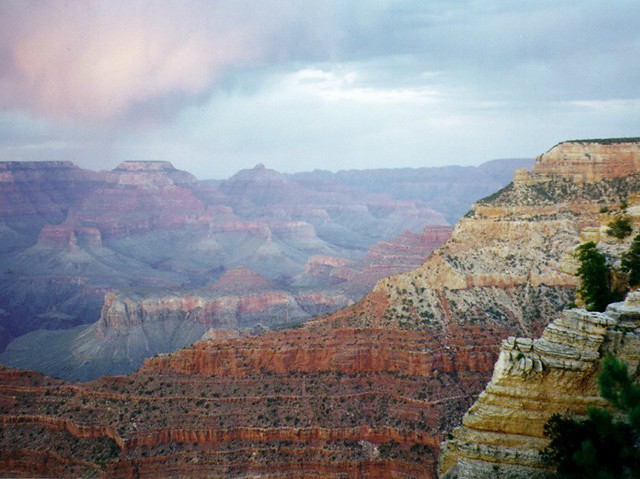
the moon and the stars you have set in place--
what are mortals that you should think of us,
mere humans that you should care for us?"
There are vistas, Lord, I'm sure You planned specifically to remind us how small we really are. Standing on the beach surveying the vastness of the ocean; overlooking the splendor of the Grand Canyon; lost in the depths of a star-studded sky. These experiences are meant to silence our busy self-importance, to humble us before You as we are reminded of Your immensity and our own helpless insignificance.
And yet our smallness finds immense signficance in You. As David expressed it as he continued his contemplation of the night sky:
and you crowned us with glory and honor.
You put us in charge of everything you made..."
Lord, lead us in wonder, humility and awe to a fuller worship of You and, in turn, to the fullness of our destiny in You. Amen.
Tuesday, June 14, 2005
What Makes for Success?
The photo is of a baby common snapping turtle I crossed paths with one fall day in southern Illinois. A couple of days ago I was watching part of a children's Saturday morning nature show with my kids as a well-known host wrestled a huge alligator snapping turtle (a different species than the one pictured here) onto shore and proceeded to discuss its early evolutionary success due, in part at least, to the fleshy appendage on its tongue which it used as a lure to catch unsuspecting fish.
Now this is a children's show and so one does not expect a PhD dissertation on how the fleshy appendage might have evolved, and I do not fault the show for not going into more detail on that. What strikes me, however, as something I'd want to know more about is how an evolutionist explains the behavioural dimension to this development. It does not seem that far-fetched to think that a fleshy appendange might genetically show up on the tongue of a snapping turtle. BUT as I understand it, in order for that to be a favorable mutation likely to be passed on to succeeding generations, it has to be useful. However, the fleshy appendage itself is not useful until somewhere along the line the turtle with this appendage discovers that it can be used to attract fish. How does this happen? And assuming that it happens, how does this newly discovered knowledge get passed along to any of the offspring fortunate enough to inherit the fleshy appendage, so that the appendage helps provide a competitive edge to that generation as well and so assure its spread through the race? They are not likely to learn the behaviour by watching an adult since turtles in general do not care for their offspring but lay the eggs and leave them to hatch and fend for themselves (like the little guy in the picture headed for the water).
As I have opportunity to learn more about the evolutionary perspective I will keep an interested eye open for explanations of how necessary behavioural modifications are explained. Not suprisingly, however, I find it much more reasonable to believe that the fleshy appendage on the tongue of the alligator snapping turtle is not the product of random chance but is there by design, and that the One who designed it also packaged the necessary behaviours to use it successfully as instinct to be passed unfailingly from generation to generation.
Sunday, May 29, 2005
Why Beauty?
If, as some suppose, we live in a world formed by purposeless processes, why should there be beauty? Autumn leaves needn't dazzle the eye with their rich multicolored display. Spring flowers needn't fascinate by color, form and fragrance. These and countless other examples can, of course, be explained by the scientific processes or necessities which underly them (recycling of chlorophyl at the end of the growing season which allows the previously masked oranges, reds and browns to emerge; reliance on color, shape and fragrance to attract insects necessary for pollination), but our capactiy to appreciate the resulting beauty should not be taken for granted. Beauty and the power to perceive it are ours by design-- for our enjoyment and inspiration, but most of all that we might be drawn to the One who is the source of all beauty and who loves it best.
What purpose does a sunset serve
but to stir the human soul--
to captivate us and intrigue
perchance to make us whole?
None, some say, it's all explained
by physics plain and clear--
the turning earth and light that's bent
through the atmosphere.
That explains the colors
but not why we should care--
not why we're captivated
by something way out there.
What holds the eye and thrills the heart
in colors in the sky?
Perhaps an understanding
that there's more than meets the eye.
Friday, May 27, 2005
An Awesome Insect -- the Monarch
I praise You God for the monarch butterfly, an awesome insect if ever there was one! Irresistably beautiful on a lazy summer day, but full of purpose in the fall-- migrating as much as three thousand miles to communal winter roosts on paper-thin wings. How can anything so seemingly frail make such a journey? How do they so unerringly find their way to these isolated mountain forests where they've never been? They are generations removed from the monarchs that wintered there the year before and then started north in the spring, each succeeding generation moving further north until there are monarchs drifting in meadows from Mexico to Manitoba. Each generation a lifespan of a few weeks until the final generation of the season. These make the two to three month journey to their winter roosts, survive the winter and head north again before producing the next generation the following spring. What a cool insect. Thank you God!

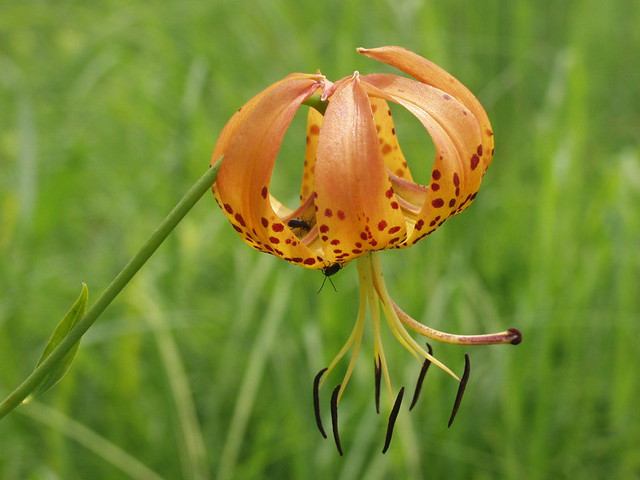


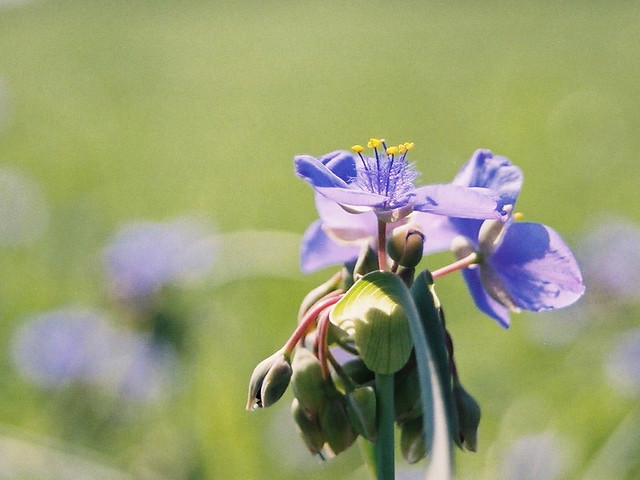
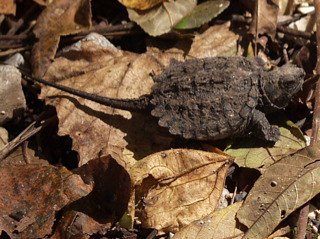
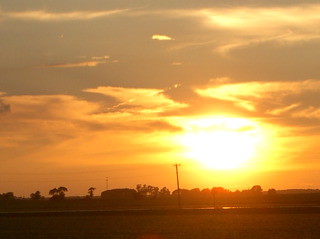
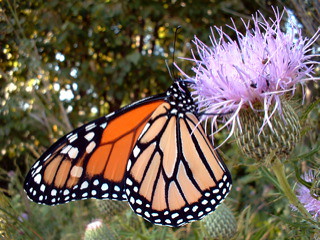

I have witnessed a monarch's first flight and it was graceful and sure. This was its first experience with wings, yet it soared above the earth as if it had been flying all its life rather than spending its entire existence clasping and crawling. Likewise, from a creature that had devoted all its waking hours to devouring milkweed leaves it had been transformed into a periodic sipper of nectar; from a life spent on its food source to a life of free flight, identifying refueling stops as needed by sight and smell from afar. Flight and feeding are just two of the more obvious abrupt behavioral changes between larva and adult-- there must be countless others as well involved in making sense of such a huge difference in body and lifestyle.
Such transformation as seen in complete metamorphosis is radical and extravagant-- certainly not, at least to my mind, something that would be easily predicted or explained by a theory of existence based on random chance occurrence and competition for survival. Certainly Lepidoptera fill their niche wonderfully, efficiently and quite successfully, being the second largest order of insects in number of species, but how on earth would such a biologically extravagant life cycle come about solely by random chance and incremental change? I'm sure explanations have been advanced and I'll be interested in reading them when the opportunity presents itself.
My contention, of course, is that this extravagant life cycle did not come about by accident but was designed for a purpose. In addition to the elegant manner in which the life cycle of butterflies and moths fits their ecological niches, I firmly believe that metamorphosis was expressly designed as a natural illustration of a powerful spiritual truth. This radical transformation in lifestyle is the perfect illustration of the spiritual transformation that takes place when anyone puts his or her faith in Christ and receives the gift of new life that God offers. As the apostle Paul wrote to the believers in Corinth:
"Therefore, if anyone is in Christ, he is a new creation; the old has gone, the new has come!" (II Corinthians 5:17)
The spiritual transformation described here is taught throughout the New Testament and is every bit as real and radical as the metamorphosis that takes place in Lepidoptera -- in fact the same Greek word is used to describe it in two passages (II Corinthians 3:18, Romans 12:2).